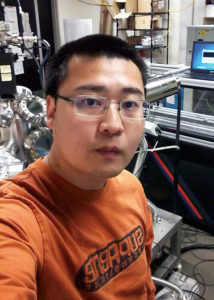 What is your thesis topic?
What is your thesis topic?
My dissertation title is “Many body physics in pseudospin- ½ iridate.” Theoretical attempts to solve any many body problem are often limited by the computational capability; thus, experimental study of representative materials becomes necessary. In systems like iridate, which combines electron correlation and spin orbit coupling, there is a rare S–½ square lattice system for studying many body physics described by Hubbard Hamiltonian. This study will provide us a better understanding of the fundamental science; additionally, it could open new possibilities for realization of exotic phenomenon like high temperature superconductivity.
How is materials processing involved in your research?
The realization of pseudospin–½ iridate systems requires state-of-the-art synthesis methods, and advanced characterization techniques are necessary to understand its properties. The key concept in the 5d transition metal oxides is the strong interplay between charge, spin, and structural degrees of freedom. While bulk single crystal iridate is often too robust, the iridate heterostructures achieved by an atomic level layer-by-layer growth technique provide a much higher tunability. The structural degree of freedom by applying epitaxial strain on the iridate heterostructure, achieved by synthesizing iridate on various substrates with different lattice mismatch, can be used to tune the strength of the electron correlation. Through characterization experiments like X-ray diffraction, the structural distortion and deformation induced by epitaxial strain can be accurately determined. Combined with the measurements of electronic and magnetic properties, we are able to understand the electron interaction under different correlation limit.
Provide an example of where the material, process, or properties you are studying might find an application.
The development of semiconductors has become more and more difficult to keep up with Moore’s law, and the focus has moved to alternative electronic devices like spintronics. The iridate superlattices can also be made into antiferromagnetic spintronics. Through an atomically controlled layer by-layer growth technique, we are able to make an iridate superlattice that approaches quasi-2D limit. By applying an external magnetic field on the iridate superlattice, the strength of magnetization and ordering temperature can be controlled. This can be used as a switch where the on and off of magnetic ordering is controlled by an external magnetic field.